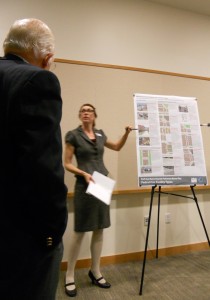
Norman Cornblatt walks three miles a day and has for as long as he can remember. Sometimes the 40-year San Mateo resident strolls to the barber, other times to the tailor, but always three miles.
Cornblatt, who lives near the busy Third Avenue and Parrott Drive intersection, is active in an informal citizens group that says the city has become unfriendly to pedestrians. Thoroughfares such as El Camino Real, which Cornblatt must cross to reach downtown, are unsafe for walkers, particularly the elderly and children, the group members say.
After years of complaining, they finally see reason for hope. The city is developing a plan to widen walkways, add green space in place of parking spots and improve lighting. The $83-million project relies on Caltrans funding at a time when state budget cuts have hit the transportation agency hard.
Stemming from a 2007 sustainability initiative, the Pedestrian Master Plan envisions a San Mateo that is more environmentally aware, in part by encouraging people to drive less often. The city projects it will add more than 17,00 residents in the next two decades, and officials want up to 30 percent of residents to walk for trips of less than one mile.
“It’s part of the entire city’s effort to … address issues like climate change,” said Ken Chin, project manager for the Public Works Department.
Chin’s department held a workshop Oct. 4 to get citizens’ ideas. On a rainy night, four people showed up for the second of two workshops and were vastly outnumbered by city staff in the room.
Alta Planning and Design, the company San Mateo hired to recommend improvements, has focused on proposals to make sure crosswalks are more visible to drivers. Plans call for adding lights and painting crosswalks with the same yellow stripes. “A lot of pedestrian collisions happen in crosswalks because a lot of people, especially motorists, don’t see the crosswalks,” Chin said. “So if we convert to high visibility crosswalks, drivers are more likely to see pedestrians.”
The plan also includes suggestions to give people more time to cross streets, and to add ramps and make it easier to step from sidewalks to crosswalks. Special emphasis has been given to improving walkways in low-income North Central San Mateo, where many residents walk or ride the bus to work out of economic necessity.
“We’re trying to improve the pedestrian environment for those folks who are already walking,” said Brett Hondorp, a senior associate with Alta. “We want to make it safer for them, and we also want to make the environment better for those who are maybe having a little bit of difficulty making the decision to walk.”
Surveys done by the Public Works department show that many of the suggestions, such as standardizing crosswalks, have been well received. But some merchants and residents question whether Caltrans has the money the city is counting on.
One of the proposed changes involves creating “parklets,” or mini parks that would extend the sidewalk area by taking up a single parking space each. “Parklets are a way to reuse existing space to create a friendly, pedestrian environment,” said Jennifer Donlon Wyant, a senior planner with Alta. Businesses stand to benefit, she said, because they could apply for an encroachment permit near parklets and expand seating outdoors.
In a city where parking is already scarce, many merchants worry that eliminating more spaces will discourage business.
“If they’re making pedestrians feel more welcomed, I’m not too concerned,” said Lisa Forte, owner of Capezio, a dance shop located near one of the proposed parklet locations at Third Avenue and B Street. “One or two spots, okay. But if they take more, that’s another thing. I’m interested in them taking some of the vacant lots and turning them into more parking spaces.”
The plan, which involves three tiers and would be implemented over 25 years, relies heavily on grants in addition to Caltrans funding. Grants often have to be matched by the city seeking them.
Some city council members are wary about approving a proposal that depends on such uncertain funding, but agree the proposed changes are positive.
“(The) council is behind the whole idea of increasing the number of pedestrians,” San Mateo Mayor Jack Matthews said. “In terms of the budget, we need to look at that, but I think the plan will likely fare well in council.”
The public has until late November to comment on the plan, at which point it will be revised and presented to the planning commission. Chin hopes to gain final approval for the improvements from the city council by March of next year.
“This plan is fabulous,” said Anna Kuhre, past president of the San Mateo United Homeowners Association and an attendee at the workshop. “I think the biggest impact is going to be public education. You have to tell school kids, tell the public, to rethink getting out of their cars.”
[youtube]Rthy_vvT2FI[/youtube]
